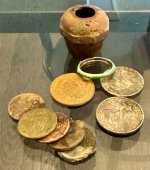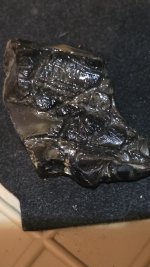kenb
Bronze Member
The mysteries around Pearl of Allah
By Redempto Anda
Southern Luzon Bureau
Last updated 05:55am (Mla time) 10/16/2007
BROOKE’S POINT, Palawan, Philippines -- Gathering dust on the floor of an unkempt government office in this town is the shell of what is believed to be the world’s largest pearl.
The Pearl of Allah or the Pearl of Lao Tzu, as the gem is now called, has been generally ignored by casual visitors used to seeing much bigger Tridacna shells displayed in local restaurants as adornment or plumbing fixture. Its history as a relic and prized treasure remains to be unearthed and properly told.
Local researchers claim to have documented narrative evidence to indicate that the pearl originated here in 1935 and was not handed to a foreigner as a gift, as generally viewed, but actually stashed away to be sold and never returned.
The gem is 9.4 inches long and weighs 14 pounds.
According to the Guinness’ Book of World Records, the San Francisco Gem Laboratory values the pearl at $40 million.
Image in clam
The Muslim diver, who found the gem, said its surface bore the image of a turbaned face, and he named it the Pearl of Allah.
Raul Quijano Jr., an engineer who also acts as the municipality’s tourism officer, and his team have made researches on the history of the pearl and to have traced the descendants of Panglima Pisi, the tribal chieftain who gave the pearl to a certain Wilburn Dowell Cobb on May 7, 1934.
“There are now doubts on the account of how the shell ended up with Mr. Cobb. He (Cobb) claimed that it was given to him for saving the life of his child from malaria.” Quijano said.
“But Panglima Pisi’s descendants are saying that it was actually given to him to be sold to a buyer. He just never came back,” he said.
Descendant
George Pisi, who claims to be a direct descendant of Panglima Pisi, possesses half of the shell where the Pearl of Allah was found. The other half was donated to the municipal government by a village official in Oring-oring where the pearl was reportedly found.
Last year, George was certified by the mayor as an authentic descendant of Panglima Pisi.
Quijano said that based on verbal accounts handed down by two generations of descendants, Panglima Pisi had asked Cobb to find a buyer for the pearl but the latter never returned to the village.
Reward
In his account published originally in the Natural History magazine in 1939, Cobb said a Muslim diver had drowned when his foot was caught by the giant Tridacna giga clam. When the body was brought to Panglima Pisi, the chieftain took possession of the bivalve and discovered the pearl inside.
Cobb said his first offer to buy the pearl from Panglima Pisi was turned down. But when he returned to the village in 1939, he came upon the chieftain’s dying son and helped him recover from malaria using Western medicine.
As a reward, the tribal leader supposedly gave him the pearl.
Quijano said that while much of Cobb’s account might be true, the descendants had claimed that in several instances, Panglima Pisi had gone to Borneo to try and sell the pearl.
Sold
Cobb brought the pearl back to the United States in 1939 and had it authenticated in the American Museum of Natural History.
After his death in 1980, Cobb’s estate sold the pearl to a Victor M. Barbish, a millionaire from Colorado Springs, who wanted to give it to his daughter Gina Diane Barbish. Barbish said the pearl is lodged in a Denver bank vault and a series of safe deposit boxes, and has reportedly expressed his desire to turn it over to a museum.
An Associated Press story on the pearl in 2005 quoted Barbish as saying: “It draws the wrong type of people.”
Barbish, who now owns 66 percent of the pearl, has claimed to have received an offer in 1999 from the world’s top terrorist, Osama bin Laden, for $60 million, purportedly to give to Iraqi leader Saddam Hussein.
He also claimed that an emissary of President Ferdinand Marcos offered to buy it, but the deal did not push through when the Philippine dictator was ousted from power in 1986.
Chinese legend
Based on Barbish’s accounts, a Chinese merchant, who is a descendant of the ancient Chinese philosopher Lao Tzu, told him that the pearl dated back to the Sui dynasty.
Lao Tzu, the founder of Taoism, had reportedly wanted to spend his final years far from civilization. As he prepared to depart, he handed to a nephew a small amulet to be placed inside a clam, where it grew to become the Pearl of Lao Tzu.
Eventually, the legend continues, the pearl was lost in a shipwreck centuries ago, then found in 1934 by a diver who drowned when he reached into a huge clam to take it.
Early this year, a Colorado jury awarded a $34.4-million share on the pearl to the heirs of a woman whose husband, bar owner Joe Bonicelli, was linked to her murder in 1975.
His children now reportedly want the pearl sold so they can be paid the settlement they won against their father’s estate.
kenb
By Redempto Anda
Southern Luzon Bureau
Last updated 05:55am (Mla time) 10/16/2007
BROOKE’S POINT, Palawan, Philippines -- Gathering dust on the floor of an unkempt government office in this town is the shell of what is believed to be the world’s largest pearl.
The Pearl of Allah or the Pearl of Lao Tzu, as the gem is now called, has been generally ignored by casual visitors used to seeing much bigger Tridacna shells displayed in local restaurants as adornment or plumbing fixture. Its history as a relic and prized treasure remains to be unearthed and properly told.
Local researchers claim to have documented narrative evidence to indicate that the pearl originated here in 1935 and was not handed to a foreigner as a gift, as generally viewed, but actually stashed away to be sold and never returned.
The gem is 9.4 inches long and weighs 14 pounds.
According to the Guinness’ Book of World Records, the San Francisco Gem Laboratory values the pearl at $40 million.
Image in clam
The Muslim diver, who found the gem, said its surface bore the image of a turbaned face, and he named it the Pearl of Allah.
Raul Quijano Jr., an engineer who also acts as the municipality’s tourism officer, and his team have made researches on the history of the pearl and to have traced the descendants of Panglima Pisi, the tribal chieftain who gave the pearl to a certain Wilburn Dowell Cobb on May 7, 1934.
“There are now doubts on the account of how the shell ended up with Mr. Cobb. He (Cobb) claimed that it was given to him for saving the life of his child from malaria.” Quijano said.
“But Panglima Pisi’s descendants are saying that it was actually given to him to be sold to a buyer. He just never came back,” he said.
Descendant
George Pisi, who claims to be a direct descendant of Panglima Pisi, possesses half of the shell where the Pearl of Allah was found. The other half was donated to the municipal government by a village official in Oring-oring where the pearl was reportedly found.
Last year, George was certified by the mayor as an authentic descendant of Panglima Pisi.
Quijano said that based on verbal accounts handed down by two generations of descendants, Panglima Pisi had asked Cobb to find a buyer for the pearl but the latter never returned to the village.
Reward
In his account published originally in the Natural History magazine in 1939, Cobb said a Muslim diver had drowned when his foot was caught by the giant Tridacna giga clam. When the body was brought to Panglima Pisi, the chieftain took possession of the bivalve and discovered the pearl inside.
Cobb said his first offer to buy the pearl from Panglima Pisi was turned down. But when he returned to the village in 1939, he came upon the chieftain’s dying son and helped him recover from malaria using Western medicine.
As a reward, the tribal leader supposedly gave him the pearl.
Quijano said that while much of Cobb’s account might be true, the descendants had claimed that in several instances, Panglima Pisi had gone to Borneo to try and sell the pearl.
Sold
Cobb brought the pearl back to the United States in 1939 and had it authenticated in the American Museum of Natural History.
After his death in 1980, Cobb’s estate sold the pearl to a Victor M. Barbish, a millionaire from Colorado Springs, who wanted to give it to his daughter Gina Diane Barbish. Barbish said the pearl is lodged in a Denver bank vault and a series of safe deposit boxes, and has reportedly expressed his desire to turn it over to a museum.
An Associated Press story on the pearl in 2005 quoted Barbish as saying: “It draws the wrong type of people.”
Barbish, who now owns 66 percent of the pearl, has claimed to have received an offer in 1999 from the world’s top terrorist, Osama bin Laden, for $60 million, purportedly to give to Iraqi leader Saddam Hussein.
He also claimed that an emissary of President Ferdinand Marcos offered to buy it, but the deal did not push through when the Philippine dictator was ousted from power in 1986.
Chinese legend
Based on Barbish’s accounts, a Chinese merchant, who is a descendant of the ancient Chinese philosopher Lao Tzu, told him that the pearl dated back to the Sui dynasty.
Lao Tzu, the founder of Taoism, had reportedly wanted to spend his final years far from civilization. As he prepared to depart, he handed to a nephew a small amulet to be placed inside a clam, where it grew to become the Pearl of Lao Tzu.
Eventually, the legend continues, the pearl was lost in a shipwreck centuries ago, then found in 1934 by a diver who drowned when he reached into a huge clam to take it.
Early this year, a Colorado jury awarded a $34.4-million share on the pearl to the heirs of a woman whose husband, bar owner Joe Bonicelli, was linked to her murder in 1975.
His children now reportedly want the pearl sold so they can be paid the settlement they won against their father’s estate.
kenb





